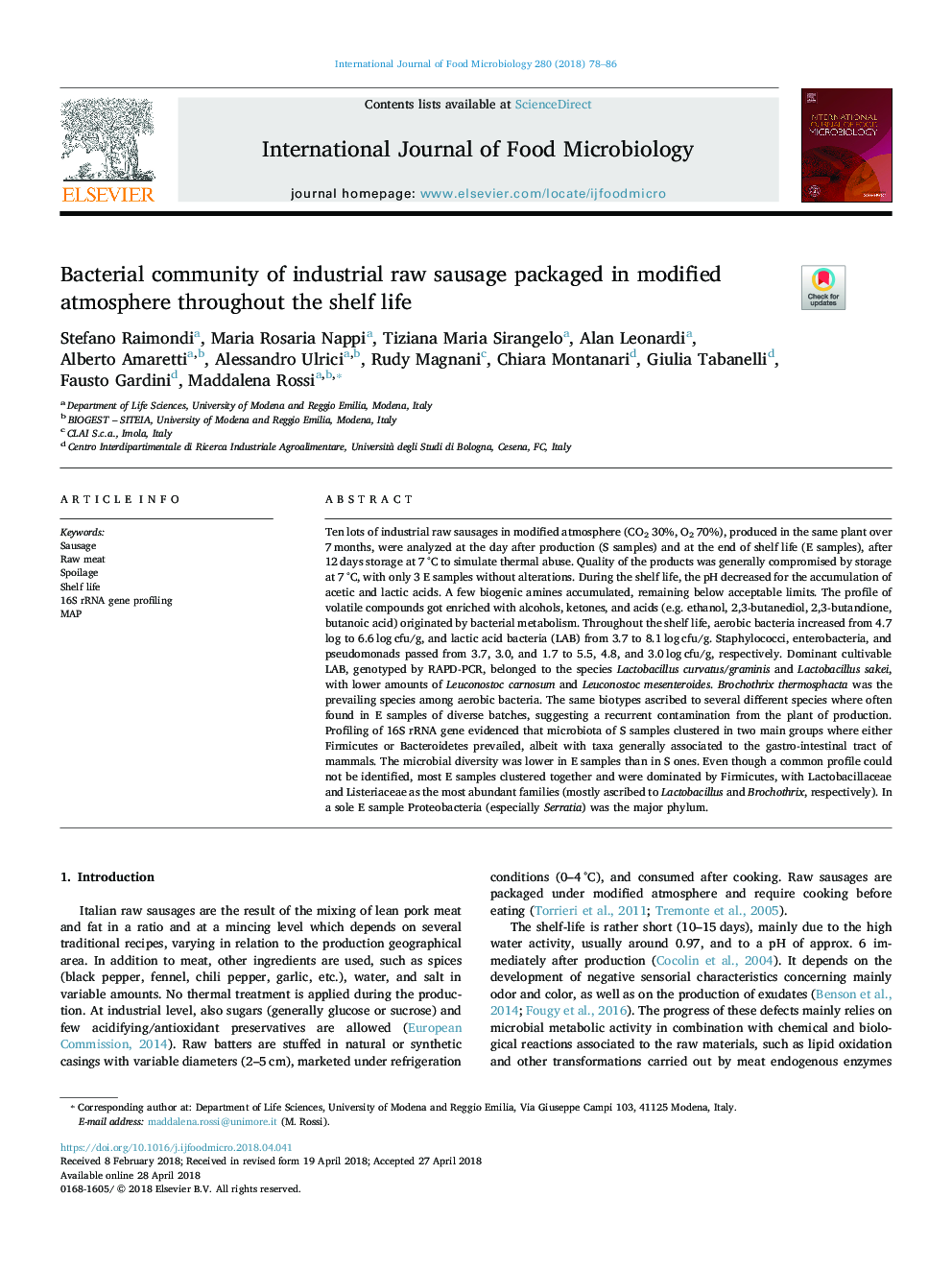| کد مقاله | کد نشریه | سال انتشار | مقاله انگلیسی | نسخه تمام متن |
|---|---|---|---|---|
| 8844148 | 1616503 | 2018 | 9 صفحه PDF | دانلود رایگان |
عنوان انگلیسی مقاله ISI
Bacterial community of industrial raw sausage packaged in modified atmosphere throughout the shelf life
ترجمه فارسی عنوان
جامعه باکتریایی سوسیس های خام صنعتی بسته بندی شده در فضای اصلاح شده در طول عمر مفید
دانلود مقاله + سفارش ترجمه
دانلود مقاله ISI انگلیسی
رایگان برای ایرانیان
موضوعات مرتبط
علوم زیستی و بیوفناوری
علوم کشاورزی و بیولوژیک
دانش تغذیه
چکیده انگلیسی
Ten lots of industrial raw sausages in modified atmosphere (CO2 30%, O2 70%), produced in the same plant over 7â¯months, were analyzed at the day after production (S samples) and at the end of shelf life (E samples), after 12â¯days storage at 7â¯Â°C to simulate thermal abuse. Quality of the products was generally compromised by storage at 7â¯Â°C, with only 3 E samples without alterations. During the shelf life, the pH decreased for the accumulation of acetic and lactic acids. A few biogenic amines accumulated, remaining below acceptable limits. The profile of volatile compounds got enriched with alcohols, ketones, and acids (e.g. ethanol, 2,3-butanediol, 2,3-butandione, butanoic acid) originated by bacterial metabolism. Throughout the shelf life, aerobic bacteria increased from 4.7 log to 6.6â¯logâ¯cfu/g, and lactic acid bacteria (LAB) from 3.7 to 8.1â¯logâ¯cfu/g. Staphylococci, enterobacteria, and pseudomonads passed from 3.7, 3.0, and 1.7 to 5.5, 4.8, and 3.0â¯logâ¯cfu/g, respectively. Dominant cultivable LAB, genotyped by RAPD-PCR, belonged to the species Lactobacillus curvatus/graminis and Lactobacillus sakei, with lower amounts of Leuconostoc carnosum and Leuconostoc mesenteroides. Brochothrix thermosphacta was the prevailing species among aerobic bacteria. The same biotypes ascribed to several different species where often found in E samples of diverse batches, suggesting a recurrent contamination from the plant of production. Profiling of 16S rRNA gene evidenced that microbiota of S samples clustered in two main groups where either Firmicutes or Bacteroidetes prevailed, albeit with taxa generally associated to the gastro-intestinal tract of mammals. The microbial diversity was lower in E samples than in S ones. Even though a common profile could not be identified, most E samples clustered together and were dominated by Firmicutes, with Lactobacillaceae and Listeriaceae as the most abundant families (mostly ascribed to Lactobacillus and Brochothrix, respectively). In a sole E sample Proteobacteria (especially Serratia) was the major phylum.
ناشر
Database: Elsevier - ScienceDirect (ساینس دایرکت)
Journal: International Journal of Food Microbiology - Volume 280, 2 September 2018, Pages 78-86
Journal: International Journal of Food Microbiology - Volume 280, 2 September 2018, Pages 78-86
نویسندگان
Stefano Raimondi, Maria Rosaria Nappi, Tiziana Maria Sirangelo, Alan Leonardi, Alberto Amaretti, Alessandro Ulrici, Rudy Magnani, Chiara Montanari, Giulia Tabanelli, Fausto Gardini, Maddalena Rossi,
